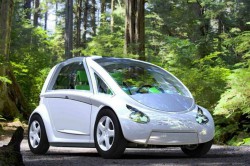Move over electric cars, here comes a cleaner, greener, cheaper, lighter model
Several technical, economic and environmental roadblocks stand in the way of full EV deployment. All cars are manufactured based on stamped steel-based chassis. This makes it very difficult to reduce vehicle weight, which is the main hurdle for EVs. Manufacturing lines are heavily automatised, resulting in high capital expenditure and few job opportunities. Lastly, the car manufacturing process has a huge environmental impact on each life-cycle phase. The EU-funded SOFTCAR project introduced a vehicle architecture that offers the lowest possible ecological footprint while offering the same safety and performance levels as other EVs. “Owing to the massive use of biopolymers and advanced composite materials, we’re able to significantly reduce vehicle weight and complexity without compromising safety,” says Dr Francois Vuille, company chairman of SOFTCAR Ltd. Project partners successfully proved that a four-wheel, low-weight car can be produced that meets the technical and safety performance of conventional EVs. They demonstrated the feasibility of both the novel vehicle architecture and manufacturing process based on advanced rotomoulding for the bioplastic body parts. The team also demonstrated the ability of the innovative materials and architecture to meet stringent crash test standards. Attractive return and environmental value proposition “The project represents a paradigm shift in car conception and manufacturing,” notes Dr Vuille. This is due to the sustainable materials, disruptive architecture and breakthrough manufacturing. SOFTCAR maximises the use of bioplastics and advanced recyclable composite materials. The large amount of advanced materials is responsible for the reduction in both parts and weight. It weighs two and a half times less than a typical car. The entire body is composed of five single material parts. In fact, the vehicle consists of 1 800 parts, compared to 40 000 for traditional EVs. This should lower production costs by about 40 %. Using an advanced rotomoulding process, biopolymer parts can be produced in 20 minutes. Structural parts are based on composite materials manufactured with the conventional glass-mat thermoplastic method. “The versatility and flexibility of our platform offers new customer value,” adds Dr Vuille. SOFTCAR’s manufacturing platform enables the production of a large variety of car models in small series while maintaining economic competitiveness. Since the body can be replaced in 30 minutes, customers have the option of changing the shape and colour of their car along with the different seasons. The platform is also very well suited for fleets and autonomous vehicles. Fleet owners can meet their needs by ordering the manufacture of a few hundred vehicles. The architecture and drivetrain are perfectly compatible with the requirements for making autonomous vehicles. The SOFTCAR vehicle was finalised in 2018. The consortium is planning to produce 20 vehicles in 2019 and then go into production in 2020. “Thanks to SOFTCAR’s pioneering architecture and eco-design approach, a new generation of EVs will be produced with unprecedented low levels of production costs, environmental footprint and capital expenditure,” concludes Dr Vuille. “Our ultimate aim is to sell production licences all over the world.”
Keywords
SOFTCAR, car, EV, vehicle, composite materials, vehicle weight, vehicle architecture, biopolymer, environmental footprint

